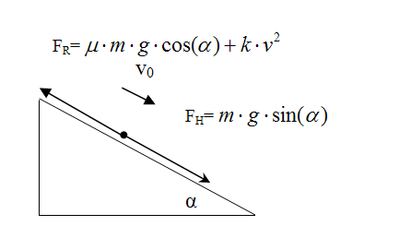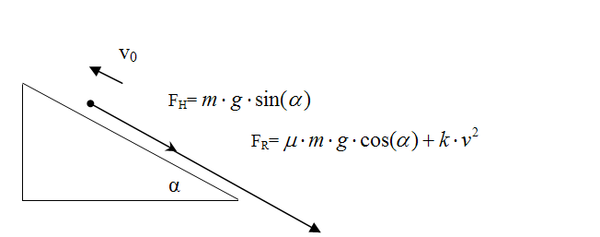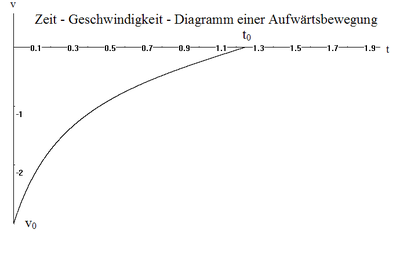This article deals with mechanics.
An inclined , sloping or inclined plane (short respectively colloquially slope , skew , slant or inclination ) is in the mechanism a plane which is opposite the surface horizontal is inclined. It is used to reduce the effort required to change the height of a mass - but the effort required remains unchanged (similar to a lever or pulley block ). The inclined plane is one of the most elementary simple machines on which numerous mechanical modes of action are based, for example it forms the basis of simple machines such as wedge or screw .
In the case of an inclined plane with an inclination angle of 45 ° (corresponding to an increase of 100%), the distance for lifting a weight of e.g. B. 10 m in the vertical to about 14.1 m along the inclined plane, which reduces the effort (neglecting the friction) to 71%. If the angle of inclination is halved to 22.5 ° (equal to an incline of 41.5%), the distance is extended to around 22 m, the effort required is reduced to around 45% compared to direct lifting.


everyday life

A ramp gives access to the upper floor.

There are often ramps parallel to stairs for bicycles and strollers.
This principle can be used, for example, in serpentines in mountains, ramps that were used in ancient times to erect buildings, bicycle or wheelchair ramps , etc. Screws can also be viewed as cylinders ( rods ) with a coiled inclined plane.
The Wedge tool also uses the inclined plane principles.
Physical basics
The following describes the situation of a mass at rest in equilibrium on an inclined plane.
The weight of a mass that is on an inclined plane has its point of application in the center of gravity of the mass. It is broken down into two components to describe the problem, the downhill component of the weight force parallel to the surface of the inclined plane and the normal component of the weight force perpendicular to the surface. A strict distinction must be made between the real acting forces and the decomposition of the weight force into two components - the components are not acting forces. The normal force which acts on the mass from below is a contact force and is perpendicular to the plane. Your point of application is not in the center of gravity of the contact area, since the pressure is not constant. The amount of the normal force is equal to the amount of the normal component of the weight force. Another force that acts is the static friction force.This is also a contact force and acts in the center of gravity of the contact surface - but is parallel to the plane and opposite to the direction of the downhill force component of the weight force







So that the body remains at rest, the downhill force must not be greater than the maximum possible static friction force . The latter is given by the static friction coefficient and the amount of normal force . The following applies:





If this condition is not met (e.g. because the angle of inclination of the plane is too large or the coefficient of static friction is too small), the mass begins to slide.

If the mass has a speed or other forces are acting, additional considerations and case distinctions must be made, which are not yet described here. The detailed mathematical description of the mass at rest on the inclined plane is given in the next section.
Body at rest

Inclined plane with an angle of inclination α
Red is the weight and its breakdown into its components, green is the contact forces between the body and the base.
The following terms are used:
-
 : Weight of the mass,
: Weight of the mass,
-
 : Normal component of weight
: Normal component of weight
-
 : Normal force ,
: Normal force ,
-
 : Downhill component of the weight force
: Downhill component of the weight force
-
 : Static friction force,
: Static friction force,
-
 : Angle of inclination of the inclined plane,
: Angle of inclination of the inclined plane,
-
 : Coefficient of static friction ,
: Coefficient of static friction ,
- ( : Coefficient of sliding friction)

-
 : Height of the inclined plane,
: Height of the inclined plane,
-
 : Base of the inclined plane as well
: Base of the inclined plane as well
-
 : Length of the inclined plane.
: Length of the inclined plane.
The weight force can be divided into a component perpendicular to the inclined plane (normal component) and a component parallel to the inclined plane (downhill component ).





A normal force and a static friction force act on the contact surface between the body and the inclined plane

Since the body is at rest, the amount of the static friction force must be exactly the same as the amount of the downhill force component of the weight force :



The following also applies accordingly:

With the law of friction:

the necessary condition results:

If the angle of inclination is too large or the coefficient of friction is too small, equilibrium is not possible and the body slips.


The coefficient of static friction (sometimes referred to as ) is always greater than the coefficient of sliding friction


It should be noted that:
- the slope as the ratio and

- the increase than the ratio

referred to as.
Gliding motion (translation only) with air resistance
In the following, the air resistance force should be taken into account when moving the body on the inclined plane. In contrast to the section above, the body is no longer at rest. Air resistance and sliding friction are effective. The constant depends on the shape of the body and the density of the flowing medium (e.g. air). The following applies:



Where:
-
 : the drag coefficient,
: the drag coefficient,
-
 : the body cross-sectional area,
: the body cross-sectional area,
-
 : the density of the flowing medium as well
: the density of the flowing medium as well
-
 : the coefficient of sliding friction.
: the coefficient of sliding friction.
Quite complex equations of motion arise from the force approaches - these differential equations can, however, be solved.
Downward movement

From the force approach:

the differential equation follows:

With:

A distinction must be made between the following cases:
- a)
Approach:

Substituting it into the differential equation, taking into account:

and by comparison of coefficients:
 and
and 
The solution is:
![{\ displaystyle {\ dot {v}} = {\ sqrt {\ frac {c} {k}}} \ tanh \ left [{\ frac {t {\ sqrt {ck}}} {m}} + \ operatorname {Artanh} \ left ({\ vec {v}} _ {0} {\ sqrt {\ frac {k} {c}}} \ right) \ right] \ ,.}](https://wikimedia.org/api/rest_v1/media/math/render/svg/f5708eb526595214b0fd2cdad48c984ee329053f)
-
 is the top speed.
is the top speed.

-
 is the hyperbolic tangent .
is the hyperbolic tangent .

- b)
-
 or.
or. 
Taking into account one obtains:

![{\ displaystyle {\ dot {v}} = - {\ sqrt {- {\ frac {c} {k}}}} \ tan \ left ({\ frac {\ sqrt {-ck}} {m}} \ left (t-t_ {0} \ right) \ right); t \ in \ left [{0; t_ {0}} \ right] \ ,.}](https://wikimedia.org/api/rest_v1/media/math/render/svg/853fa9c1826e030126f343498d9ef4659385c6e3)
At this point the body comes to rest.

The following applies to the braking distance :


- c)
-
 or.
or. 

The speed approaches rest in a hyperbolic shape, but the braking distance is infinitely long.
Upward movement

From the force approach:

the differential equation follows:

With:

Approach:


Substituting it into the differential equation, taking into account:

and by comparing coefficients one obtains:
-
 and
and 
The solution is:
![{\ displaystyle {\ dot {v}} = {\ sqrt {\ frac {c} {k}}} \ tan \ left ({\ frac {\ sqrt {ck}} {m}} \ left (t-t_ {0} \ right) \ right); t \ in \ left [{0; t_ {0}} \ right]}](https://wikimedia.org/api/rest_v1/media/math/render/svg/fc7cac40df047f3c1d0bdcfc7db2efc131bd2d28)
at the time:

the body comes to rest, where is negative.

The following applies to the braking distance :

![{\ displaystyle s = \ int \ limits _ {0} ^ {t_ {0}} {{\ dot {v}} t \, \ mathrm {d} t = - {\ frac {m} {k}} \ ln \ left (\ cos \ left [\ arctan \ left (\ left | v_ {0} \ right | {\ sqrt {\ frac {k} {c}}} \ right) \ right] \ right)} \, .}](https://wikimedia.org/api/rest_v1/media/math/render/svg/e3d5491fb8aa3a21080cd10dfc7a70e34b7cbd2c)
rotation
The conservation of energy can be applied to the rotation: The potential energy at the beginning of the movement is converted into translational and rotational energy.

This means:

In the special case of a cylinder or a sphere, the object moves around the path during one revolution . That means that we have the secondary condition for this special case:


because of :
and thus:



this can be simplified too

The speed of rotation results at the end of the acceleration as

and the translation speed is:

For the special case of a homogeneous solid cylinder is the moment of inertia . For a hollow cylinder with a negligibly thin edge is the moment of inertia . The speeds are thus:




Web links
Individual evidence
-
^ A b Jürgen Eichler : Physics: Basics for engineering studies . Vieweg Verlag , Braunschweig / Wiesbaden 1993, ISBN 978-3-528-04933-1 , p. 31 , doi : 10.1007 / 978-3-322-96859-3 ( Google Books ).






















































![{\ displaystyle {\ dot {v}} = {\ sqrt {\ frac {c} {k}}} \ tanh \ left [{\ frac {t {\ sqrt {ck}}} {m}} + \ operatorname {Artanh} \ left ({\ vec {v}} _ {0} {\ sqrt {\ frac {k} {c}}} \ right) \ right] \ ,.}](https://wikimedia.org/api/rest_v1/media/math/render/svg/f5708eb526595214b0fd2cdad48c984ee329053f)







![{\ displaystyle {\ dot {v}} = - {\ sqrt {- {\ frac {c} {k}}}} \ tan \ left ({\ frac {\ sqrt {-ck}} {m}} \ left (t-t_ {0} \ right) \ right); t \ in \ left [{0; t_ {0}} \ right] \ ,.}](https://wikimedia.org/api/rest_v1/media/math/render/svg/853fa9c1826e030126f343498d9ef4659385c6e3)














![{\ displaystyle {\ dot {v}} = {\ sqrt {\ frac {c} {k}}} \ tan \ left ({\ frac {\ sqrt {ck}} {m}} \ left (t-t_ {0} \ right) \ right); t \ in \ left [{0; t_ {0}} \ right]}](https://wikimedia.org/api/rest_v1/media/math/render/svg/fc7cac40df047f3c1d0bdcfc7db2efc131bd2d28)


![{\ displaystyle s = \ int \ limits _ {0} ^ {t_ {0}} {{\ dot {v}} t \, \ mathrm {d} t = - {\ frac {m} {k}} \ ln \ left (\ cos \ left [\ arctan \ left (\ left | v_ {0} \ right | {\ sqrt {\ frac {k} {c}}} \ right) \ right] \ right)} \, .}](https://wikimedia.org/api/rest_v1/media/math/render/svg/e3d5491fb8aa3a21080cd10dfc7a70e34b7cbd2c)













